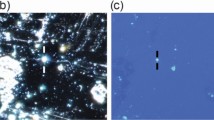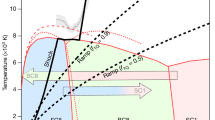Abstract
Despite almost forty years of trying, no one has managed to transform diamond into graphite under pressure1, or find out what the pressure limit for diamond might be2. If diamond were to behave like other group IV elements, such as silicon, germanium or tin, it would transform under compressive indentation to the β-tin structure3, but it does not2,4. Here we use micro-Raman spectroscopy to determine what happens to diamond when it is subjected to high contact compression as a result of pressing a sharp diamond indenter against its surface4. We find that, under this non-hydrostatic compression, diamond at the point of indentation is transformed into disordered graphite. This discovery may eventually lead to the more efficient machining of diamond.
This is a preview of subscription content, access via your institution
Access options
Subscribe to this journal
Receive 51 print issues and online access
$199.00 per year
only $3.90 per issue
Buy this article
- Purchase on Springer Link
- Instant access to full article PDF
Prices may be subject to local taxes which are calculated during checkout

Similar content being viewed by others
References
Yin, M. T. & Cohen, M. L. Phys. Rev. Lett. 50, 2006–2009 (1983).
Mao, H. K. & Hemley, R. J. Nature 351, 721–724 (1991).
Gilman, J. J. Science 261 1436–1439 (1993).
Gogotsi, Y. G., Kailer, A. & Nickel, K. G. J. Appl. Phys. 84, 1299–1304 (1998).
Gogotsi, Y. G., Kailer, A. & Nickel, K. G. Mater. Res. Innov. 1, 3–9 (1997).
Kailer, A., Gogotsi, Y. G. & Nickel, K. G. J. Appl. Phys. 81, 3057–3063 (1997).
Ruoff, A. L. & Luo, H. J. Appl. Phys. 70, 2066–2070 (1991).
Ruoff, A. L. & Wanagel, J. Science 198, 1037–1038 (1977).
Grillo, S. E. & Field, J. E. J. Phys. D 30, 202–209 (1997).
Van Bouwelen, F. M., Brown, L. M. & Field, J. E. Ind. Diamond Rev. 57, 21–25 (1997).
Cahn, R. W. Nature 357, 645–646 (1992).
Author information
Authors and Affiliations
Additional information
brief communications is intended to provide a forum for both brief, topical reports of general scientific interest and technical discussion of recently published material of particular interest to non-specialist readers. Priority will be given to contributions that have fewer than 500 words, 10 references and only one figure. Detailed guidelines are available on Nature's website (www.nature.com/author/guide.html#7.4) or on request from nature@nature.com
Rights and permissions
About this article
Cite this article
Gogotsi, Y., Kailer, A. & Nickel, K. Transformation of diamond to graphite. Nature 401, 663–664 (1999). https://doi.org/10.1038/44323
Issue Date:
DOI: https://doi.org/10.1038/44323
This article is cited by
-
Progress and prospect of diamond dynamic friction polishing technology
The International Journal of Advanced Manufacturing Technology (2023)
-
Anisotropic mechanical responses and plastic deformation mechanisms of cadmium telluride under indentations
Applied Physics A (2022)
-
Phase transformation and subsurface damage formation in the ultrafine machining process of a diamond substrate through atomistic simulation
Scientific Reports (2021)
-
Understanding controversies in the α-ω and ω-β phase transformations of zirconium from nonhydrostatic thermodynamics
Scientific Reports (2019)
-
Sunset yellow dye doped ammonium dihydrogen phosphate single crystals with enhanced optical, mechanical and piezoelectric properties
Journal of Materials Science: Materials in Electronics (2019)
Comments
By submitting a comment you agree to abide by our Terms and Community Guidelines. If you find something abusive or that does not comply with our terms or guidelines please flag it as inappropriate.



